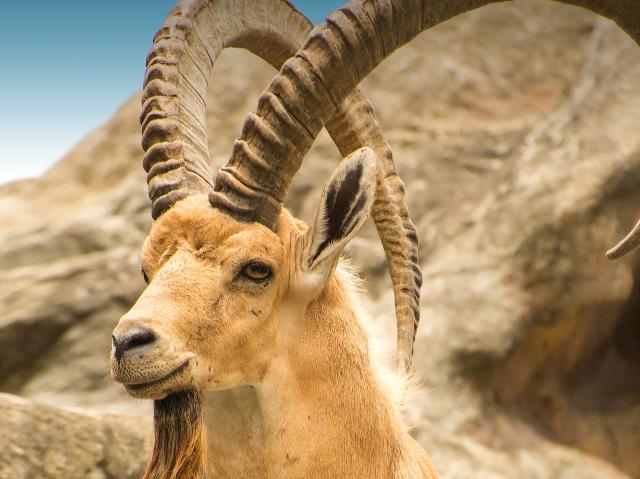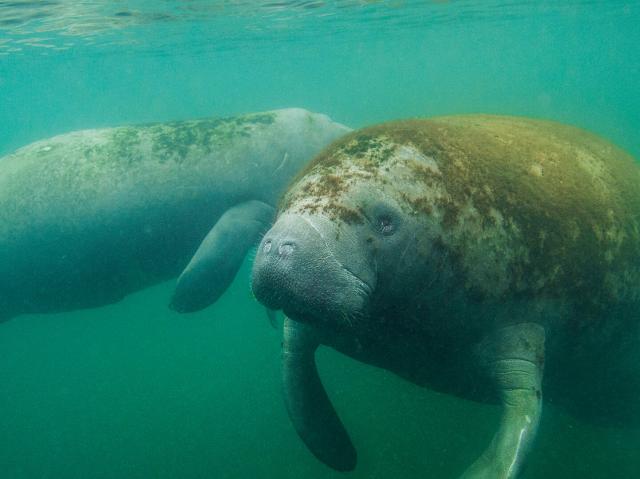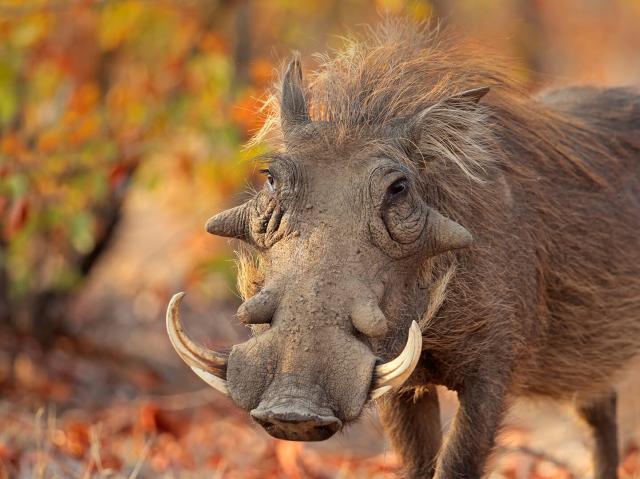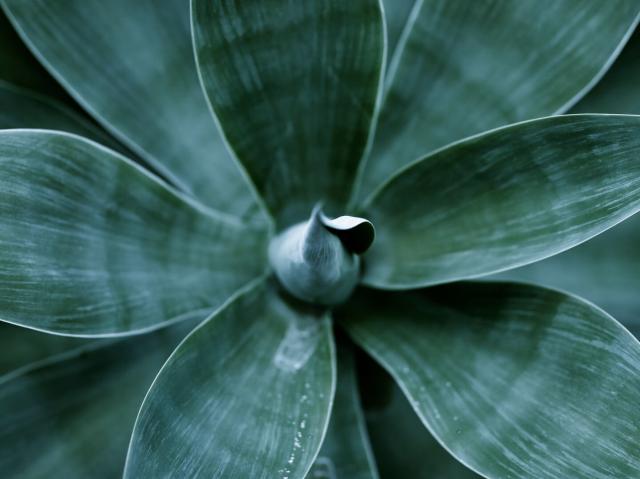
Hippo

- CLASS: Mammalia (Mammals)
- ORDER: Artiodactyla
- FAMILY: Hippopotamidae
- GENUS: Hippopotamus
- SPECIES: amphibious

ABOUT
What's in a name? Watch a hippo, on land or in the water, and you’ll soon discover that this roly-poly is one of the world’s great characters. It is the most rotund land mammal and spends its daytime hours in lakes, pools, mudholes, or in the preferred moving waters of rivers.
The name “hippopotamus” comes from a Greek word meaning “water horse” or “river horse.” But hippos are not related to horses at all—in fact, their closest living relatives may be pigs or whales and dolphins! There are two species of hippopotamus: the river, or common, hippo and the much smaller pygmy hippo.
Hippos have unique skin that needs to be kept wet for a good part of the day. Staying out of the water for too long can lead to dehydration, so hippos try to remain in water during the day. They don’t have true sweat glands; instead, hippos secrete a thick, red substance from their pores known as "blood sweat," as it looks like they are sweating blood. But not to worry! The blood sweat creates a layer of mucous that protects hippo skin from sunburn and keeps it moist. It is thought that this mucous may also prevent infections; even large wounds don't seem to get infected despite the filthy water hippos sometimes live in in their native habitat.
In the unpredictable African wilderness, hippos face many perils, such as disease and drought. A full-grown adult doesn’t have much in the way of natural predators. Lions have been known to take down hippos, but it depends upon how many lions, the age of the hippo, and how far it is from the water.
But simply reaching adulthood is a challenge. Crocodiles, lions, hyenas, and leopards are all potential threats while growing up—but the most dangerous thing to a young hippo is another hippo. When you live in a group that may contain as many as 100 individuals, disagreements are bound to happen. Sometimes young hippos get caught in the middle of violent clashes between adults and can be bitten or crushed—occasionally by their own parent.
Despite the hippos' cute appearance, they are among the most dangerous and aggressive of all mammals. Their canine and incisor teeth grow continuously, with canines reaching 20 inches (51 centimeters) in length. Hippo males especially use their canines for fighting. To ward off enemies, a hippo may yawn, scoop water with its mouth, shake its head, rear up, lunge, roar, grunt, chase, and make a loud wheezing sound, all of which are threat displays. A hippo can kill people if it's provoked or feels threatened. But the impressive tusks and canine teeth are used mainly for defense or fighting with other hippos.
HABITAT AND DIET
Hippos are definitely adapted for life in the water and are found living in slow-moving rivers and lakes in Africa. With their eyes, ears, and nostrils on the top of the head, hippos can hear, see, and breathe while most of their body is underwater. Hippos also have a set of built-in goggles: a clear membrane covers their eyes for protection while still allowing them to see when underwater. Their nostrils close, and they can hold their breath for five minutes or longer when submerged. Hippos can even sleep underwater, using a reflex that allows them to bob up, take a breath, and sink back down without waking up.
Yet despite all these adaptations for life in the water, hippos can't swim—they can't even float! Their bodies are far too dense to float, so they move around by pushing off from the bottom of the river or simply walking along the riverbed in a slow-motion gallop, lightly touching the bottom with their toes, which are slightly webbed, like aquatic ballet dancers.
During daylight hours, hippos spend almost all of their time wallowing in shallow water. In the evening, after the hot sun has set, hippos come out of the water for a night of grazing—in fact, this goes on for about six hours! Despite their enormous weight, hippos eat an average of only 88 pounds (40 kilograms) of food a night. This amount is about 1 to 1.5 percent of their body weight. By comparison, the largest cattle eat 2.5 percent of their body weight each day.
While hippos like to feed on patches of short grasses (called “hippo lawns”) close to water, they must sometimes travel several miles (kilometers) to find food, making long trips on land to new lakes or rivers. Their ears help them hear the sounds of falling fruit, and their keen sense of smell helps them sniff out the tasty treats. Hippos are mostly inactive unless eating, and this helps them conserve energy.
At the San Diego Zoo, the hippos eat herbivore pellets, alfalfa and Bermuda hay, lettuce and mixed vegetables, and on special occasions, melons.
FAMILY LIFE
The hippopotamus is social, living in groups of 10 to 30 individuals. They have even been seen in much larger groups of up to 200 individuals! The herd has several adult females and several adult males, but there is one dominant male. He has the right to mate with all adult females in his herd, although he sometimes allows subordinate males in and around his territory to mate. The dominant male reminds other hippos of his territory by flinging his dung as far as possible with his fan-shaped tail!
When rival males meet, they stand nose to nose with their mouth open as wide as possible, up to a 150-degree angle! This is called "gaping," a way to size each other up. Usually the smaller male retreats without being pursued by the larger hippo. When two hippos do decide to fight, they slash out with their tusks or swing their enormous heads like sledgehammers while bellowing loudly. They have been known to die as a result of a very aggressive battle.
The breeding season for hippos is linked to the dry season, so that most births happen during the wettest time of the year. Hippos prefer to breed in the water but can also do so on land. Amazingly, the gestation period for such a large mammal is just 8 months—slightly shorter than the human gestation period—yet the hippo calf is about 10 times larger than a human baby! When the female nears the time to give birth, she leaves the herd for one or two weeks to give birth to her young and create a bond with her baby. She is comfortable giving birth in water or on land.
If the baby is born underwater, the mother needs to push it to the surface to breathe. Newborn hippos are only able to hold their breath for about 40 seconds at a time. The mother stays in the water with her newborn for several days without eating, and she waits until her baby is strong enough before they dare leave the water at night to graze. Mothers nurse their babies, even underwater, for about eight months.
Hippos are surprisingly noisy: some hippo vocalizations have been measured at 115 decibels, about the same volume as being 15 feet away from the speakers at a rock concert! They also use snorts, grumbles, “wheeze-honking,” and other ground-shaking—and sometimes subsonic—vocalizations to communicate to other hippos. As one starts calling, the rest of the family “sounds off” down the line.
AT THE ZOO
Puddles was the first hippopotamus at the San Diego Zoo; born on July 8, 1935 at the Brookfield Zoo outside of Chicago. He arrived here in August 1936, becoming the first hippo to be cared for by a zoo on the West Coast. He became quite the sensation.
Rube and Ruby were popular from the moment they arrived in 1940 as youngsters from the Calcutta Zoo in India. The pair produced 11 offspring during their time together, with their first calf born in 1943. Hippos have an average life span of 25 to 30 years in the wilderness, but Rube’s 51 years made him one of the oldest hippos in human care. Although Ruby died in 1982 and Rube in 1988, they have been immortalized as two of the Zoo’s popular costumed characters! During their time here, hippos became some of the Zoo’s most popular wildlife, seen by millions of visitors.
By 1986, the Zoo's 50-year-old hippo habitat was showing its age, and a decision was made to close it until it could be replaced with an up-to-date facility. That facility became a reality when a new hippo habitat opened at the Zoo in 1995. It continues to offer millions of people a safe way to get an up-close-and-personal view of hippos. Zoo visitors can observe hippo behavior on the beach and underwater all year long, as their habitat features 110 feet (33.5 meters) of underwater viewing behind a 2.25-inch-thick (5.7 centimeters) glass window, engineered to withstand the force of a 2-ton (1.8 tonnes) hippo moving at 15 miles per hour (24 kilometers per hour). Thanks to the temperate San Diego weather, the water in the pool does not need to be heated or chilled.
The pool is serviced by a large water filtration system and is also kept clean by a school of tilapia, one of the several African fish that, in their native habitat, would normally be feeding on the hippos’ dead skin and food remnants.
CONSERVATION
Although hippos are not yet endangered, their habitat has been greatly reduced over the last 200 years. Once common to all of Africa, hippos are now abundant only in East Africa. Male hippos stake a claim to a stretch of river and all the females in it. It is his job to protect the group from intruders. An unsuspecting human boater who enters hippo territory risks an aggressive response. Female hippos, especially mothers with calves, can be equally dangerous and unpredictable. Sometimes, it is the hippo that invades human areas like local farmlands, devouring crops.
With the constant growth of human settlements, human and hippo territories frequently overlap, and these encounters are on the rise. Projects such as the building of dams or the diversion of water for agriculture often have disastrous impacts on natural waterways and the hippos that depend on them.
Even more devastating to hippo populations is the trade in illegal ivory. Following the 1989 ban on elephant ivory, demand for hippo ivory sharply increased. The large canines that hippos use to protect themselves are made of the same material as elephants’ tusks. In fact, they are slightly softer and easier to carve than elephant ivory, making them even more appealing. As a result, hippo numbers are rapidly decreasing. If hippos were to disappear completely, the effect on their habitat would be catastrophic. The large amount of waste hippos produce fertilizes the African ecosystem, and many fish eat the dung and feed on the small parasites that live on the hippos’ skin.
Elephants, cheetahs, and many other “at risk” African wildlife have organizations focused on their conservation, but there is no such group devoted to the future of hippos. Right now, the most promising way to protect hippos is to continue to safeguard large areas of land, as national parks offer the greatest amount of protection against poaching.
Sounds
LIFE SPAN
Median life expectancy is 36 years
YOUNG
Gestation: 8 months
Number of young at birth: 1
Weight at birth: 50 to 110 pounds (25 to 45 kilograms)
Age of maturity: Females, 5 to 6 years; males, 7 years average
SIZE
Length: 10.8 to 16.5 feet (3.3 to 5 meters)
Height: Up to 5.2 feet (1.6 meters) tall at shoulder
Weight: Females, 3,000 pounds (1,400 kilograms) average; males, 3,500 to 9,920 pounds (1,600 to 4,500 kilograms)
FUN FACTS
An adult hippo can hold its breath underwater for five minutes or longer when submerged.
When agitated, a hippo can charge at up to 14 miles per hour (30 kilometers per hour) on land.
Hippos can store two days' worth of grass in their stomachs and can go up to three weeks without eating.
Hippos vocalize on both land and in the water and are the only mammals that make amphibious calls.
Hippos have stiff whiskers above the upper lip and some fuzziness around their ears and on their tail.
A group of hippos is sometimes called a bloat, pod, or siege.
The hippo is similar in size to the white rhinoceros.
In African rivers, hippos look like floating islands, with birds fishing from their backs. Turtles and even baby crocodiles have been seen sunning themselves on hippos.










